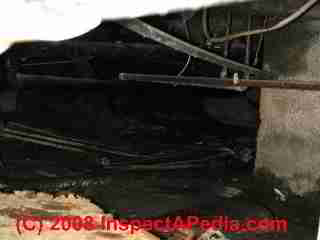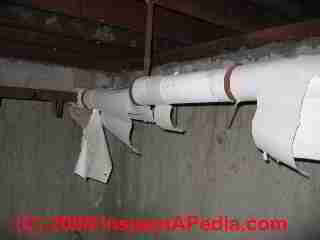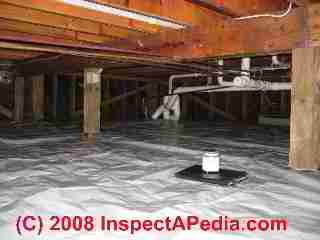 Crawl Space Mold, Rodents, Asbestos Clean-up FAQs
Crawl Space Mold, Rodents, Asbestos Clean-up FAQs
Q&A on how to clean up & dry out a crawl area
- POST a QUESTION or COMMENT about how to address mold, rodents, asbestos or other crawl space contaminants
How to clean out a crawl space contaminated with mold, rodents, asbestos, or sewage.
Here we discuss safety precautions and cleaning approaches for a dirty or contaminated building crawl space. We explain that first you should inspect the crawl space for visible signs of unsanitary or unhealthy contaminants.
InspectAPedia tolerates no conflicts of interest. We have no relationship with advertisers, products, or services discussed at this website.
How Clean Up the crawl space: remove asbestos, mold, rodent droppings, unsanitary soils, insulation

These questions and answers about how to clean up a crawl space to remove water, mold, rodent, and other hazards were posted originally at CRAWL SPACE CLEAN UP - you will want to check out that advice.
On 2019-02-05 by (mod) - Who to contact re slab ductwork.
(mod) said:
Start with your local HVAC contractors.
Terri said:
Who to contact re slab ductwork. Possible rodent and water issue(s). Help
On 2019-02-05 by (mod) - crawl space humidity target
Anon: see details of indoor humidity targets
On 2017-06-19 by Anonymous
What should be the humidity range in a residential house crawl space?
Question: Hurricane Sandy flooded our Ocean City NY House - what do I do in the crawl space?
Hurricane Sandy hit my old Sears House (1930's)in Ocean City, NJ so the water was 1 foot deep on the first floor (the floor being 3 feet off the ground!)
Sometime within the last 25 years the water was deep enough to get the insulation wet and it was removed at that time and not replaced (The house is not heated in the winter).
What should I do in the crawl space area?
If I would encapsulate the crawl space, it would be like a swimming pool next time it floods. Ideas on a good solution? Is a spray insulating foam worthwhile for protecting flooring from underneath? Thanks!
Rick - 11/12/2012
I have also a home in Ocean City, NJ that got hit with Sandy. I have just pulled out the mostly wet insulation. I got water damaged in my first floor from the water seeping up from the craw space.
Electric wires are down now and I am worried about structural damage.
Can anyone recommend someone in South Jersey who could do work of reinforcing existing floor supports?
These past week I am worried that those who are hired to do work are being extremely careless and doing other damage. THanks - Roberta 11/13/2012
Reply: tips for improving the resistance of crawl spaces to flood damage
Closed-cell foam products are somewhat resistant to wetting from flooding or other water intrusion in a building crawl space or anywhere else, but if a building area is actually inundated with floodwaters again after such an installation, I'd be concerned about the difficulty and cost of disinfecting or addressing the risks of sewage-contaminated floodwaters.
For this reason, just taking up some closed cell foam board can be problematic - how will you clean the space that was soaked with sewage waters between the foam boards and framing or subfloor above?
Talk with spray foam insulation contractors in your area about the water resistance of sprayed-in-place closed cell foam insulation.
That product actually adheres to wood surfaces, a step that may resist sewage-contaminated water from entering the space between the insulation itself and wood surfaces that otherwise would need cleaning.
See
- CRAWL SPACE INSULATION RETROFIT
- OPEN-CELL vs CLOSED CELL FOAM INSULATION and take a look at and compare
- FOAM INSULATION TYPES - visual identification of different types of foam insulation products
- ICYNENE FOAM SPRAY INSULATION
- POLYISOCYANURATE FOAM and IAQ
- URETHANE FOAM DETERIORATION & OFF GASSING where we discuss polyurethane as well as urethane closed cell foam insulation
In addition, sealing the exposed wood and interior foundation surfaces with a sanitizing or fungicidal sealant (after they are thoroughly dry) will also reduce the moisture uptake (and sewage-contaminated water uptake) of those surfaces in future flooding, making surface cleaning and area dryout a bit faster after the next flood.
- See MOLD SANITIZER, SPRAY, BIOCIDE USE GUIDE for details. Our photo above shows a crawl space after an extensive cleanup; the remediator installed 6 mil or heavier plastic on the crawl space floor, and all surfaces were coated with a sealant.
- Also take a look at FLOOD VENTS & FLOOD PORTS - a product installed to deliberately allow floodwaters into a basement or crawl space to reduce the risk of foundation collapse due to outside floodwater pressures.
Frankly, if the home is likely to be flooded to a depth that submerges the first floor or higher, no crawl space encapsulation is going to completely protect the building; if you cannot afford to raise the building on a taller, flood-damage-resistant foundation or pier system, I'd be troubled about the prospect of recurrent, perhaps even increasingly frequent significant cleaning and repair costs from future area flooding.
Question: are my crawl space "dryout" fans blowing moldy wet dust and debris and maybe chemicals from a wet crawl space into the living area?
I recently moved to an 800 square foot single story historic house in Pacific Grove. The home has a very shallow crawl space (as little as 6" near the perimeter- the foundation is only 12" deep) and the crawl space was covered with a moisture barrier when I bought the home.
It has a solid concrete wall bisecting the underneath of the house (the long way).
I had termites and was advised by the inspector that the house is very damp underneath. They recommended removal of the moisture barrier and installation of fans to dry out the space. I have been having symptoms like I get when I am exposed to dust (dry, red nose) and feel very uncomfortable ever since the fans went in. This is driving me absolutely nuts.
The crawl space is wetter now than before (it has rained).
I can't put in a french drain because there is only about 6" clearance between my house's crawl boxes and the fence, also it is on top of the sewer lateral.
I live on a hill in an area known to have underground springs but nobody knows exactly where they run.
I think they should remove the fans and put the moisture barrier back.
Do you agree? Is there anything else I can do? Perimeter moisture barrier?
Thank you. There is lots of mold down here and I am concerned that just putting the moisture barrier back will cause mold or rot. - S.A. 2/7/2013
Reply: how not to "dry out" a wet moldy crawl space
Sounds as if you got some advice that was good in intent but not competent.
I do on occasion recommend adding a fan to increase air movement in a crawl area or basement where a dehumidifier is at work, as that will increase the rate at which the dehumidifier can dry out the area. But just blowing air around in a wet moldy crawl space seems like a bad idea.
Removing the moisture barrier from the crawl floor and blowing fans turns the crawl space into a moisture pump, moving moisture from soil into the crawl space air. Perhaps if the fans blew OUT of the crawl space that might have been better, but the proper approach is to find and fix sources of water entry, seal (poly is ok) the floor, and dehumidify the area.
Watch out: there is an added risk of blowing pesticide contaminated dust and debris into the home if the applicator used a surface spray - something that's not usually done for termites.
Usually for termites the pest control officer places a termiticide in the soil around the home; but in a home with a dirt crawl space they may be unable to take that approach because of the risk of chemicals surfacing in the crawl area and entering the living area - making occupants sick. So I'm not sure what has been done about your termite issue but that too needs expert review.
I suspect that dust, possibly allergens (insect fragments, mold, even soil particles, potentially other particles) have been stirred up; and if the fans were not blowing out of the crawl area, it may have been pressurized by the air movement; if that's the case, the arrangement may have increased the movement of particles up into the living area from the crawl space.
More likely you need to stop the fans, find and fix outdoor water sources like roof or surface runoff spilling by the foundation, put the poly back down to stop pumping water into the crawl area, and after the mold problem has been evaluated and most likely removed (cleaning the wood surfaces, tossing out insulation), then you might get a fan and dehumidifier back at work to keep the area dry.
...
Continue reading at CRAWL SPACE CLEAN UP or select a topic from the closely-related articles below, or see the complete ARTICLE INDEX.
Or see these
Recommended Articles
- CRAWL SPACE CLEAN UP
- CRAWL SPACE DEBRIS
- CRAWL SPACE DISINFECTANTS & SANITIZERS, SOURCES
- CRAWL SPACE DRYOUT - home
Suggested citation for this web page
CRAWL SPACE CLEAN UP FAQs at InspectApedia.com - online encyclopedia of building & environmental inspection, testing, diagnosis, repair, & problem prevention advice.
Or see this
INDEX to RELATED ARTICLES: ARTICLE INDEX to CRAWL SPACES
Or use the SEARCH BOX found below to Ask a Question or Search InspectApedia
Ask a Question or Search InspectApedia
Try the search box just below, or if you prefer, post a question or comment in the Comments box below and we will respond promptly.
Search the InspectApedia website
Note: appearance of your Comment below may be delayed: if your comment contains an image, photograph, web link, or text that looks to the software as if it might be a web link, your posting will appear after it has been approved by a moderator. Apologies for the delay.
Only one image can be added per comment but you can post as many comments, and therefore images, as you like.
You will not receive a notification when a response to your question has been posted.
Please bookmark this page to make it easy for you to check back for our response.
Our Comment Box is provided by Countable Web Productions countable.ca
Citations & References
In addition to any citations in the article above, a full list is available on request.
- In addition to citations & references found in this article, see the research citations given at the end of the related articles found at our suggested
CONTINUE READING or RECOMMENDED ARTICLES.
- Carson, Dunlop & Associates Ltd., 120 Carlton Street Suite 407, Toronto ON M5A 4K2. Tel: (416) 964-9415 1-800-268-7070 Email: info@carsondunlop.com. Alan Carson is a past president of ASHI, the American Society of Home Inspectors.
Thanks to Alan Carson and Bob Dunlop, for permission for InspectAPedia to use text excerpts from The HOME REFERENCE BOOK - the Encyclopedia of Homes and to use illustrations from The ILLUSTRATED HOME .
Carson Dunlop Associates provides extensive home inspection education and report writing material. In gratitude we provide links to tsome Carson Dunlop Associates products and services.


